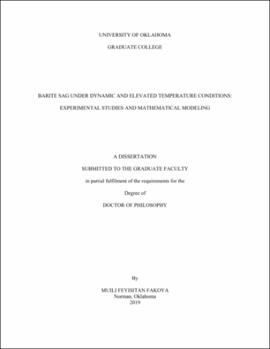| dc.description.abstract | Barite sag is an undesired occurrence that causes density variation in the wellbore. It is a problem that is related to both fluid property (mainly rheology) and drilling practices, and it arises mostly in invert emulsion muds. Due to the complexity of barite sag, the mechanisms that initiate and exacerbate its occurrence are still not completely understood. Drilling problems such as lost circulation, wellbore instability, and stuck pipe result from this undesired phenomenon. Drilling operations are capital-intensive projects, thus, more solution-driven researches are needed for barite sag minimization.
The objective of this research is to study barite sag from the perspective of particle size, mud rheology, rotational speed, and inclination angle, and also, develop a mathematical model for barite sag predictions. Thus, the investigation includes different experimental approaches (fluid rheology tests and barite sag investigations using rotational viscometer and flow loop) and mathematical modeling.
In order to establish a relationship between barite sag, and shear rate and temperature, experimental investigations were conducted on the rheology of oil-based mud (OBM) and its continuous phase at different shear rates and temperatures. Organophilic clay concentration and the oil-water ratio (OWR) were varied during the investigation. For comparison purposes, the rheology of water-based mud (WBM) was also studied. In rotational viscometer experiments, different barite types were prepared by sieving regular API barite. The prepared barite samples were used to make weighted oil-based muds (OBMs). Then, barite sag investigations were performed by applying the Viscometer Sag Shoe Test (VSST) method at different particle sizes and rotational speeds. The flow loop investigations were conducted to better understand the effects of pipe rotation and inclination angle on barite sag under dynamic condition. Furthermore, barite sag occurring in a vertical mud column is modeled by adopting the sedimentation-consolidation model. The new model has incorporated the shearing (dynamic) effect and the non-Newtonian behavior of OBM. Model solution was obtained using the fully implicit finite difference method.
The OBMs exhibit shear-thinning behavior that is best fitted with the Herschel-Bulkley model. The outcomes show remarkable trends of apparent viscosity and rheological parameters as temperature, organophilic clay concentration, and OWR increase. Rheological models are developed using nonlinear regression analysis, and reasonable predictions of OBM apparent viscosities are made. The rheological parameters and apparent viscosity of OBM and WBM are normalized, and their comparison shows why OBM is more vulnerable to barite sag events than WBM. The VSST results indicate that barite sag increases with increasing average particle diameter and rotational speed. The normalized mud densities obtained from the flow loop results reveal interesting trends in the top and bottom sections of the mud column as pipe rotational speed and inclination angle increase. The developed barite sag model gives reasonable predictions of the VSST results. Parametric studies show that barite sag will decrease with decreasing particle size, but, will increase as the unweighted OBM rheological parameters decrease.
This research provides a comprehensive approach to study barite sag. The combination of OBM and continuous phase rheology, particle size distribution effect, rotational speed, and inclination angle will facilitate a better understanding of barite sag and minimize its occurrence. | en_US |
